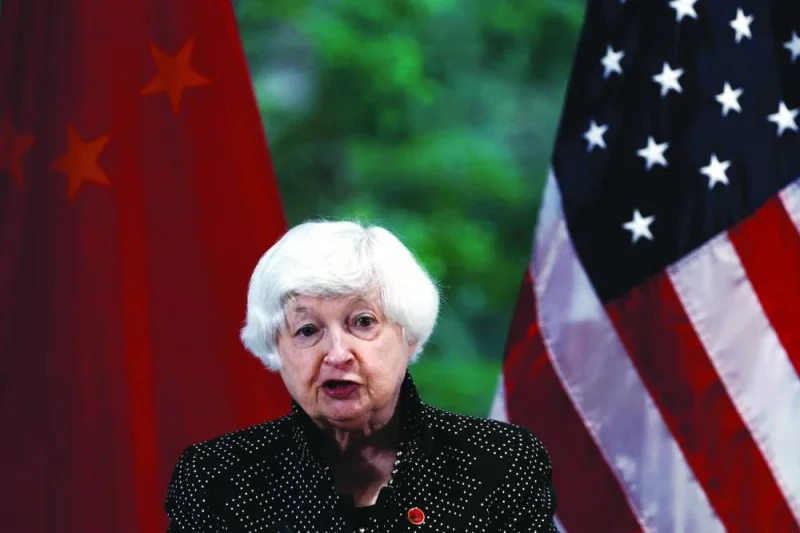US Treasury Secretary Janet Yellen’s nearly week-long visit to China, now underway, will most likely focus on US concerns about Chinese subsidies to producers of electric vehicles and other clean-tech goods. While the availability of cheap EVs is good news for the planet and for consumers everywhere, it is bad news for shareholders and employees of Western car companies, and both the US and the European Union are considering imposing import tariffs on Chinese EVs. But tariffs are the wrong approach.
EVs are superior to ICE (internal combustion engine) cars in many ways. They are the world’s best hope for decarbonising passenger vehicles, short of moving away from cars altogether. They can provide crucial energy storage capacity for the electric grid, aiding broader decarbonisation efforts, which in turn will cut EVs’ carbon footprint further. And their faster acceleration and smoother ride underpinned the early success of Tesla and other high-end EVs.
That first-mover advantage has since dissipated. Tesla has lost 30% of its market value since January, struggling to keep up with BYD and other much cheaper Chinese competitors. That, too, is good news for the climate. Chinese oil demand is likely to have peaked last year, according to China’s state oil company. The reason is obvious: EVs and hybrids now account for roughly 40% of new car sales, twice the global share.
Some of the Chinese government’s EV subsidies are justified, both on the supply and the demand sides. They can represent the best option for internalising positive learning-by-doing and scale externalities, and for helping producers climb the learning curve and slide down the cost curve beyond what the market would deliver on its own. That is especially true for batteries, a key input in the EV supply chain. The patent system provides crucial incentives for private innovation, but it does so highly imperfectly. Research and development has positive social spillovers, making it deserving of taxpayers’ support.
Targeted demand subsidies are similarly justified, because they speed up EV adoption, helped by positive learning-by-doing and network externalities. The latter calls for direct support for an increase in the number of charging stations, itself deserving of direct subsidies (though over time, policymakers should phase down subsidies and instead increase gasoline taxes).
While the success of Chinese EVs has spooked Western car manufacturers, some of the pain is self-inflicted. Having bet on massive gas-guzzlers for too long, they delayed the all-but-inevitable switch to EVs. But that’s not all: Chinese EVs are cheaper for the same reason that most everything manufactured in China tends to be cheaper than American or European products.
Introducing EV tariffs in response to intense lobbying by Western car manufacturers might make for good election-year politics. After all, taxing one’s own citizens – including via carbon taxes – is politically difficult, while “taxing” others is sometimes viewed more favourably, especially by those with lower trust in government. But while some tariffs, like Europe’s Carbon Border Adjustment Mechanism (CBAM), are eminently justifiable, because they specifically address the negative carbon externality, those aimed at Chinese EVs or other products such as solar panels, which are crucial for the global green transition, are not.
A much better idea is to subsidise domestic manufacturing, an approach reflected in the US Inflation Reduction Act and Bipartisan Infrastructure Law, and in targeted EU subsidies. Some of these subsidies can be justified simply as a politically feasible, second-best alternative to carbon pricing, including as a stepping stone toward pricing policies.
Tariffs may be preferred on “public finance” grounds: they generate government revenues, while subsidies cost taxpayers money. But that calculus is shortsighted. Early analyses of the Inflation Reduction Act show that its hundreds of billions of dollars’ worth of subsidies raise economic output in the US and elsewhere, both during and after the initial decade of government spending.
European car manufacturers have realised this and are themselves now calling for further subsidies in lieu of tariffs, seeking an Airbus-like, cross-country alliance to subsidise European EV manufacturing. While any subsidy scheme is messy and raises a host of thorny political-economy and economic-efficiency questions, such subsidies are surely preferable to EV tariffs.
The threat of tariffs can serve a useful purpose, especially if, like the EU’s CBAM, it is aimed at the carbon content of traded goods, with the explicit goal being to encourage higher carbon prices elsewhere. Given the carbon intensity of Chinese manufacturing, such carbon tariffs alone could give a boost to US and especially EU EV manufacturers. But a punitive tariff that raises the prices of EVs and reduces competition is counterproductive. A subsidy race, together with stronger efforts at pricing carbon dioxide emissions, is vastly superior to a tariff war. The world will be both richer and cleaner for it. – Project Syndicate
• Gernot Wagner is a climate economist at Columbia Business School. Shang-Jin Wei, a former chief economist at the Asian Development Bank, is Professor of Finance and Economics at Columbia Business School and Columbia University’s School of International and Public Affairs.

US Treasury Secretary Janet Yellen speaks during an event by the American Chamber of Commerce in China (AmCham China) in Guangzhou, Guangdong province, on Friday.
